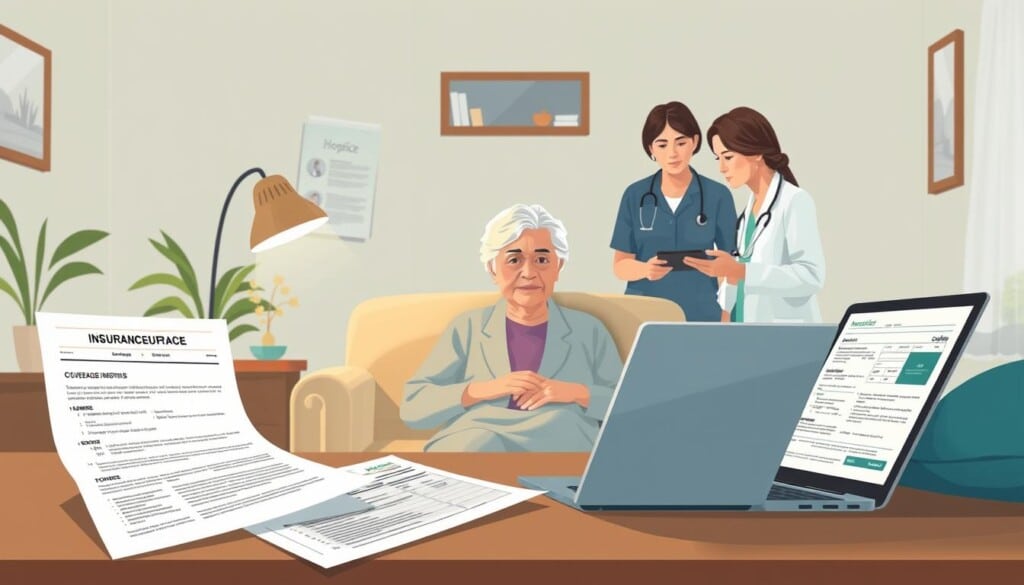What does compassionate end-of-life care really mean? Many think hospice is about giving up. But it’s actually a journey of support and dignity. Hospice care is for those with terminal illnesses, focusing on pain management and emotional support.
This care approach, like former President Jimmy Carter’s, values quality of life at the end. Hospice teams work together to offer holistic care. They help people transition peacefully, with grace, as they near the end.
Key Takeaways
- Hospice care focuses on quality of life for patients facing terminal illnesses.
- Compassionate end-of-life care includes both medical and emotional support.
- Palliative care is vital for pain management and dignity.
- Interdisciplinary teams are essential in providing holistic hospice services.
- High-profile cases have brought increased visibility to the importance of hospice care.
- It’s a misconception that hospice care means giving up; it’s about living well until the end.
What is Hospice Care?
Hospice care helps people with serious illnesses and their families. It offers many services to manage pain and symptoms. The goal is to make the patient’s life as comfortable as possible.
This care also focuses on emotional and spiritual support. It’s about improving the quality of life in the final stages.
Definition and Purpose
Hospice care is more than just medical help. It’s a complete approach to care. It aims to reduce physical pain and meet the emotional and spiritual needs of patients and their families.
The main goal is to help people live their last days with comfort and dignity. They get support from a team of experts.
Types of Hospice Services
Hospice care offers different services for each patient’s needs. Home-based care lets patients stay in their own homes. Inpatient facilities provide more intense care when needed.
Bereavement support helps families after a loved one passes away. It ensures they get the emotional support they need. Also, hospice services are available 24/7. This means help is always there for both caregivers and patients.
Eligibility for Hospice Care
To get hospice care, patients must meet certain criteria. They need a terminal diagnosis, meaning they have six months or less to live if their illness follows its natural course. A hospice doctor makes this decision after a thorough assessment.
Hospice referrals are key to starting the process. They can come from doctors, family, or the patient themselves. After a referral, a detailed assessment is done. This helps create a care plan that meets the patient’s medical, emotional, and spiritual needs.
The Hospice Care Team
The hospice care team is key in supporting patients and their families during tough times. It includes many healthcare professionals with different roles. Together, they make sure care is top-notch and meets all needs.
Roles of Healthcare Professionals
Doctors, nurses, social workers, and spiritual counselors work together. They manage pain and offer emotional support. Doctors handle medical needs, nurses focus on daily care, and social workers help with legal and financial stuff.
Spiritual counselors support by helping patients share their values and beliefs. This adds to the emotional care given.
Support from Volunteers
Volunteers play a big role in hospice care. They bring kindness and companionship to patients. They help with daily tasks, give family members a break, and offer a listening ear.
Their help makes the care experience better. It lets families focus on their loved ones while knowing their needs are met.

Benefits of Hospice Care
Hospice care offers many benefits, mainly improving life quality for those with terminal illnesses. It focuses on effective pain management. This ensures patients get the right medicines and therapies to ease their pain. This way, they can have a more peaceful time despite the challenges.
Hospice care also provides emotional support. The teams show compassion and understanding. They help patients and families deal with the emotional side of terminal illness. This support allows for open talks about sadness and fear.
Spiritual support is another key part of hospice care. Trained spiritual caregivers help with deep questions and offer comfort. This approach makes end-of-life care more complete. It addresses physical, emotional, and spiritual needs of patients and their families.
How to Choose a Hospice Provider
Finding the right hospice provider is a big step. Families need to look at different options carefully. They should check the staff’s qualifications and the care philosophy. This helps find a provider that fits the patient’s needs well.
Researching Options
Start by learning about different hospice groups. Look at their services, certifications, and how they are seen in the community. Getting advice from doctors, friends, and family can help a lot. Also, check online reviews to see what others say about their care.
Important Questions to Ask
Make a list of questions to ask hospice staff. Ask about their services, support for families, and insurance plans. Talking about these helps make sure everyone’s needs are met, creating a caring space for all.
The Role of Family in Hospice Care
Family involvement is key in hospice care. Loved ones act as caregivers and advocates for the patient. This role is vital for a better experience for all.
Support from family members helps manage daily needs. It also boosts emotional strength during tough times. Hospice provides guidance, resources, and education to families. This ensures they understand care aspects.

Family support is critical in the hospice journey. Open communication is important. It allows loved ones to share concerns and preferences.
This involvement strengthens the care process. Family members can express what aligns with the patient’s values. Hospice teams focus on emotional well-being, including family members in decisions.
This approach respects the patient’s dignity and wishes. It makes care planning proactive and inclusive.
Involving family in hospice decisions is beneficial. The hospice team values family insights. They encourage participation in treatment and care plan discussions.
This makes hospice a shared experience. It reduces isolation for patients and their relatives. It fosters unity and assurance as loved ones face this challenging phase together.
Hospice Care Settings
It’s important to know the different hospice care settings to choose the best for patients. Each setting focuses on comfort and meets individual needs. Hospice care mainly happens in two places: at home and in inpatient facilities.
Home-Based Hospice Care
Home hospice care lets patients get support in their own homes. This keeps them comfortable and in control. A hospice team visits regularly to offer medical care, emotional support, and resources.
This approach improves life quality. Patients can spend time with loved ones and get personal care.
Inpatient Hospice Facilities
Inpatient hospice facilities provide a controlled setting for those needing intense support. They have specialized staff and resources for complex symptoms and 24/7 care. These facilities are for patients needing more medical help or can’t get care at home.
Both settings aim to ensure comfort, dignity, and quality of life for each patient.
Common Misconceptions About Hospice
It’s important to understand hospice care to clear up common myths. Many people think hospice means giving up. But, it’s really about improving life quality, not just living longer. It offers comfort and support for both patients and their families.
Myths vs. Reality
Some think hospice is only for the very end. But, it can start at any serious illness stage. Hospice care focuses on managing symptoms and supporting patients and families. Starting hospice early can make a big difference in both patient and family well-being.
Understanding Hospice Philosophy
Hospice care is all about a patient-centered approach. It values the patient’s wishes, needs, and dignity. By understanding hospice, families can see its role in supporting them through tough times. Hospice is more than just end-of-life care; it’s about respecting each person’s journey and values.
Navigating Insurance and Costs
Understanding the financial side of hospice care is key. Many people get confused about what their insurance covers. Luckily, Medicare and Medicaid often pay for most hospice services. This helps a lot, making sure patients get the care they need without a huge financial hit.
It’s important for families to check their insurance plans carefully. Knowing what your insurance covers can help a lot. The costs of hospice care can change based on what services you need. Talking to hospice providers and insurance people can clear up any confusion. This helps families plan their finances better and make smart choices.

The Transition to Hospice Care
The move to hospice care is a big step for patients and their families. It’s not just about setting up care; it’s also about getting emotionally ready. Families often feel a mix of emotions, and knowing what to expect can help.
Preparing Patients and Families
Getting ready for hospice means talking about care choices and pain relief. It’s about understanding the dying process. This helps make sure the care team focuses on comfort, which is key during this time.
End-of-Life Discussions
Talking about the end of life helps families understand each other better. These conversations help families accept what’s happening and connect with each other. They’re a powerful way to deal with the emotional side of hospice care.
Local Resources for Hospice Care
Getting help from local hospice resources is key for patients and their families when times are tough. LocalZ helps people find these resources and connect with hospice providers that fit their needs. An online directory makes it easy to find services that match individual situations.
Community support for hospice is also very important. Local groups offer important resources, referrals, and emotional help. They help families dealing with this tough time by providing volunteers and support groups.
To find out what’s available, visit LocalZ. It has a detailed guide to hospice providers and community support in your area. Using local resources can make the process easier and smoother.
Conclusion: Embracing Compassionate Care
In hospice care, kindness is key. It makes the end of life more dignified and respectful for everyone involved. By focusing on each person’s needs, we create a space where they feel truly valued.
The Importance of Quality End-of-Life Care
Families need to understand the value of hospice care when making tough decisions. It’s not just about physical needs; it’s also about emotional and spiritual support. Knowing that quality care is there can bring peace of mind.
Encouragement for Families Facing Decisions
Going through hospice care is hard, but talking and learning together helps. It’s tough to prepare, but there are resources to help. By embracing hospice care’s kindness, families can cherish their time together.

